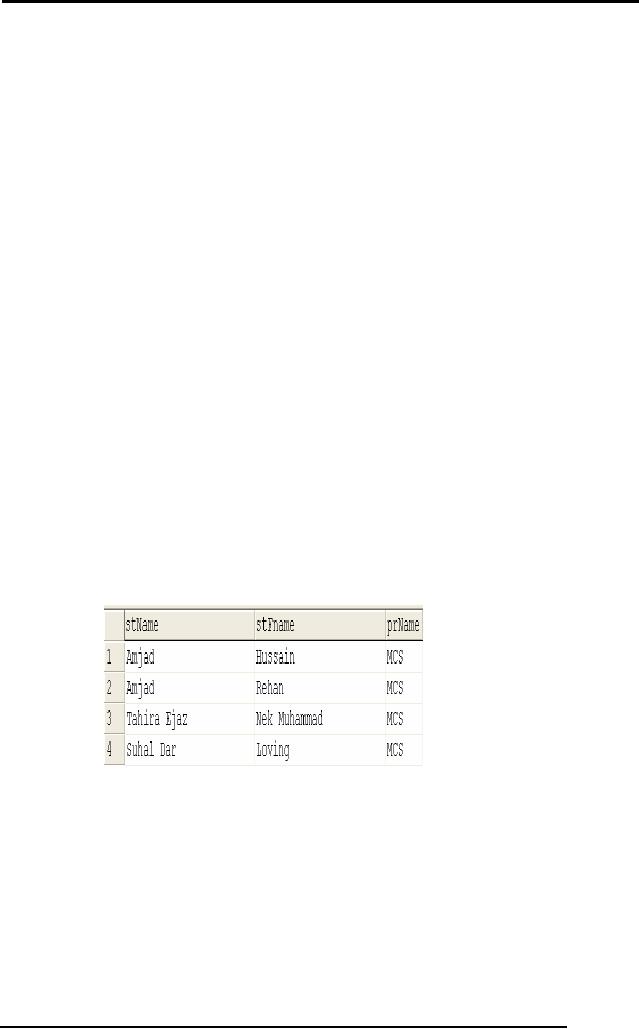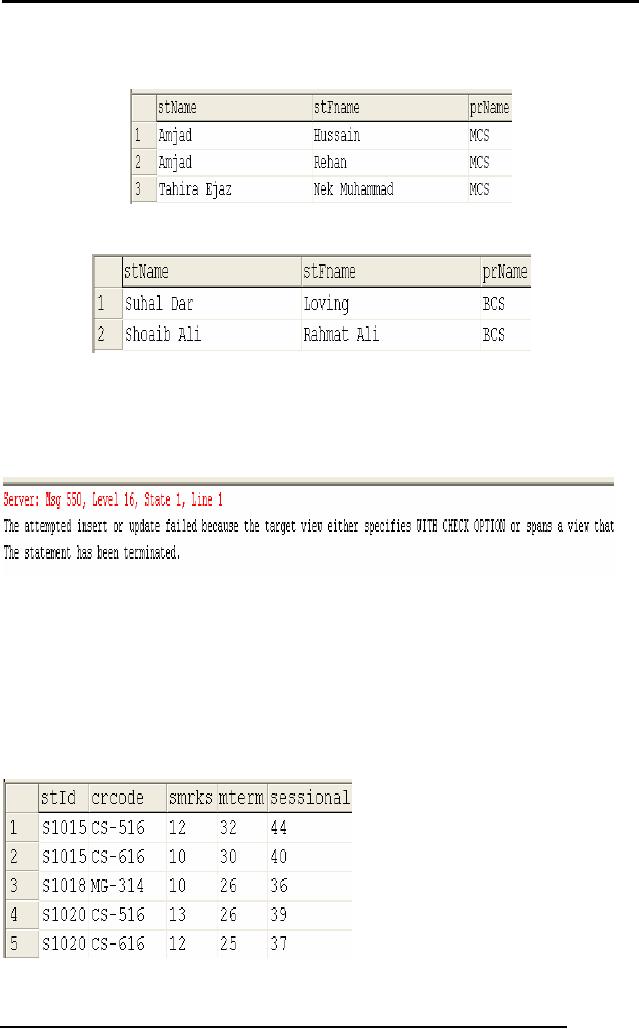 |
Materialized View, Simple Views, Complex View, Dynamic Views |
| << Views, Data Independence, Security, Vertical and Horizontal Subset of a Table |
| Updating Multiple Tables, Transaction Management >> |

Database
Management System
(CS403)
VU
that
give a group of user's
access to just the
information they are allowed
to
see.
For example, we can define a
view that allows students to
see other
students'
name and age but not their
GPA, and allow all students to
access
this
view, but not the
underlying Students
table.
There
are two ways to create a
new view in your database.
You can:
Create a
new view from
scratch.
�
Or,
make a copy of an existing
view and then modify
it.
�
Characteristics
/Types of Views:
We have a
number of views type of
which some of the important
views types are
listed
below:
�
Materialized
View
�
Simple
Views
�
Complex
View
�
Dynamic
Views.
A
materialized view is a replica of a
target master from a single
point in time.
The
master can be either a
master table at a master
site or a master
materialized
view at a materialized view
site. Whereas in
multi-master
replication
tables are continuously
updated by other master
sites, materialized
views
are updated from one or more
masters through individual
batch
updates,
known as a refreshes, from a
single master site or
master
refreshes
materialized
view site
Simple
Views
283

Database
Management System
(CS403)
VU
As
defined earlier simple views
are created from tables and
are used for
creating
secure manipulation over the
tables or structures of the
database.
Views
make the manipulations
easier to perform on the
database.
Complex
Views
Complex
views are by definition
views of type which may
comprise of many of
elements,
such as tables, views
sequences and other similar
objects of the
database.
When talking about the
views we can have views of
one table,
views
of one table and one view, views of
multiple tables views of
multiple
views
and so on...
Dynamic
Views
Dynamic
views are those types of
views for which data is
not stored and the
expressions
used to build the view
are used to collect the
data dynamically.
These
views are not executed
only once when they
are referred for the
first
time,
rather they are created and
the data contained in such
views is updated
every
time the view is accessed or
used in any other view or
query.
Dynamic
views generally are complex
views, views of views, and
views of
multiple
tables.
An
example of a dynamic view
creation is given
below:
CREATE
VIEW st_view1 AS (select stName, stFname,
prName
FROM
student
WHERE
prName = 'MCS')
284

Database
Management System
(CS403)
VU
Views
can be referred in SQL
statements like
tables
We
can have view created on
functions and other views as
well. Where the
function
used for the view
creation and the other
nested view will be used as
a
simple
table or relation.
Examples:
View
Using another View
CREATE VIEW
CLASSLOC2
AS SELECT
COURSE#,
ROOM
FROM CLASSLOC
View
Using Function
CREATE
VIEW CLASSCOUNT(COURSE#,
TOTCOUNT)
AS SELECT
COURSE#,
COUNT(*)
FROM ENROLL
GROUP BY
COURSE#;
Dynamic
Views
SELECT *
FROM st_view1
With
Check Option
CREATE VIEW
st_view2
AS (SELECT
stName,
stFname, prName FROM student
WHERE
prName =
`BCS')
WITH CHECK
OPTION
UPDATE
ST_VIEW1 set prName =
`BCS'
Where
stFname = `Loving'
285

Database
Management System
(CS403)
VU
SELECT *
from ST_VIEW1
SELECT *
FROM ST_VIEW2
Update
ST_VIEW2 set prName =
`MCS'
Where
stFname = `Loving'
Characteristics
of Views
� Computed
attributes
� Nesting
of views
CREATE
VIEW enr_view AS (select * from
enroll)
CREATE
VIEW enr_view1 as (select stId, crcode, smrks,
mterm, smrks +
mterm
sessional from enr_view)
Select *
from enr_view1
286

Database
Management System
(CS403)
VU
Deleting
Views:
A
view can be dropped using
the DROP VIEW command, which
is just like
DROP
TABLE.
Updates
on Views
Updating
a view is quite simple and
is performed in the same way
as we
perform
updates on any of the database
relations. But this
simplicity is limited
to
those views only which
are created using a single
relation. Those views
which
comprise of multiple relations
the updation are hard to
perform and
needs
additional care and
precaution.
As
we know that the views
may contain some fields
which are not the
actual
data
fields in the relation but
may also contain computed
attributes. So update
or
insertions in this case are
not performed through the
views created on
these
tables.
287
Table of Contents:
- Introduction to Databases and Traditional File Processing Systems
- Advantages, Cost, Importance, Levels, Users of Database Systems
- Database Architecture: Level, Schema, Model, Conceptual or Logical View:
- Internal or Physical View of Schema, Data Independence, Funct ions of DBMS
- Database Development Process, Tools, Data Flow Diagrams, Types of DFD
- Data Flow Diagram, Data Dictionary, Database Design, Data Model
- Entity-Relationship Data Model, Classification of entity types, Attributes
- Attributes, The Keys
- Relationships:Types of Relationships in databases
- Dependencies, Enhancements in E-R Data Model. Super-type and Subtypes
- Inheritance Is, Super types and Subtypes, Constraints, Completeness Constraint, Disjointness Constraint, Subtype Discriminator
- Steps in the Study of system
- Conceptual, Logical Database Design, Relationships and Cardinalities in between Entities
- Relational Data Model, Mathematical Relations, Database Relations
- Database and Math Relations, Degree of a Relation
- Mapping Relationships, Binary, Unary Relationship, Data Manipulation Languages, Relational Algebra
- The Project Operator
- Types of Joins: Theta Join, Equi–Join, Natural Join, Outer Join, Semi Join
- Functional Dependency, Inference Rules, Normal Forms
- Second, Third Normal Form, Boyce - Codd Normal Form, Higher Normal Forms
- Normalization Summary, Example, Physical Database Design
- Physical Database Design: DESIGNING FIELDS, CODING AND COMPRESSION TECHNIQUES
- Physical Record and De-normalization, Partitioning
- Vertical Partitioning, Replication, MS SQL Server
- Rules of SQL Format, Data Types in SQL Server
- Categories of SQL Commands,
- Alter Table Statement
- Select Statement, Attribute Allias
- Data Manipulation Language
- ORDER BY Clause, Functions in SQL, GROUP BY Clause, HAVING Clause, Cartesian Product
- Inner Join, Outer Join, Semi Join, Self Join, Subquery,
- Application Programs, User Interface, Forms, Tips for User Friendly Interface
- Designing Input Form, Arranging Form, Adding Command Buttons
- Data Storage Concepts, Physical Storage Media, Memory Hierarchy
- File Organizations: Hashing Algorithm, Collision Handling
- Hashing, Hash Functions, Hashed Access Characteristics, Mapping functions, Open addressing
- Index Classification
- Ordered, Dense, Sparse, Multi-Level Indices, Clustered, Non-clustered Indexes
- Views, Data Independence, Security, Vertical and Horizontal Subset of a Table
- Materialized View, Simple Views, Complex View, Dynamic Views
- Updating Multiple Tables, Transaction Management
- Transactions and Schedules, Concurrent Execution, Serializability, Lock-Based Concurrency Control, Deadlocks
- Incremental Log with Deferred, Immediate Updates, Concurrency Control
- Serial Execution, Serializability, Locking, Inconsistent Analysis
- Locking Idea, DeadLock Handling, Deadlock Resolution, Timestamping rules